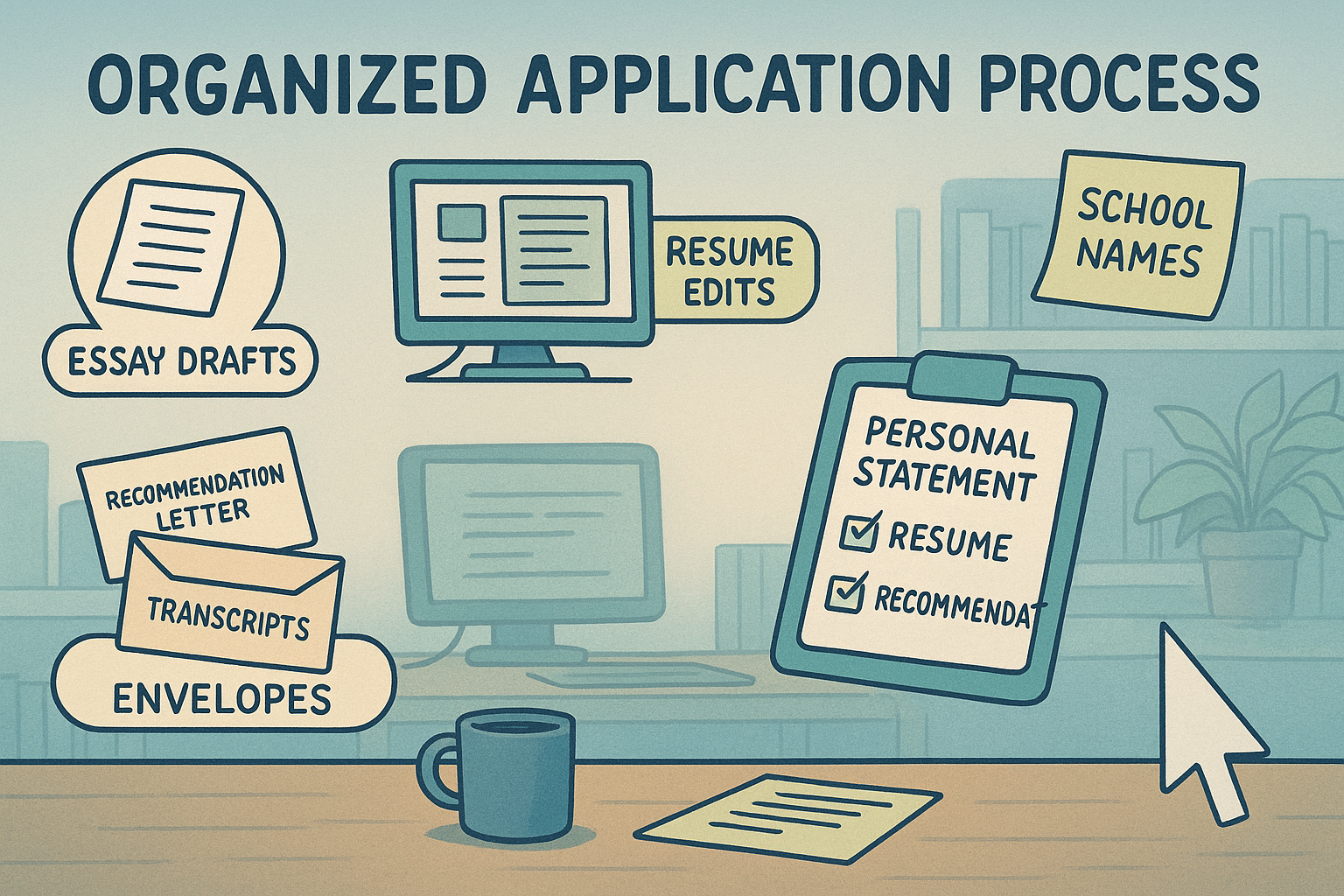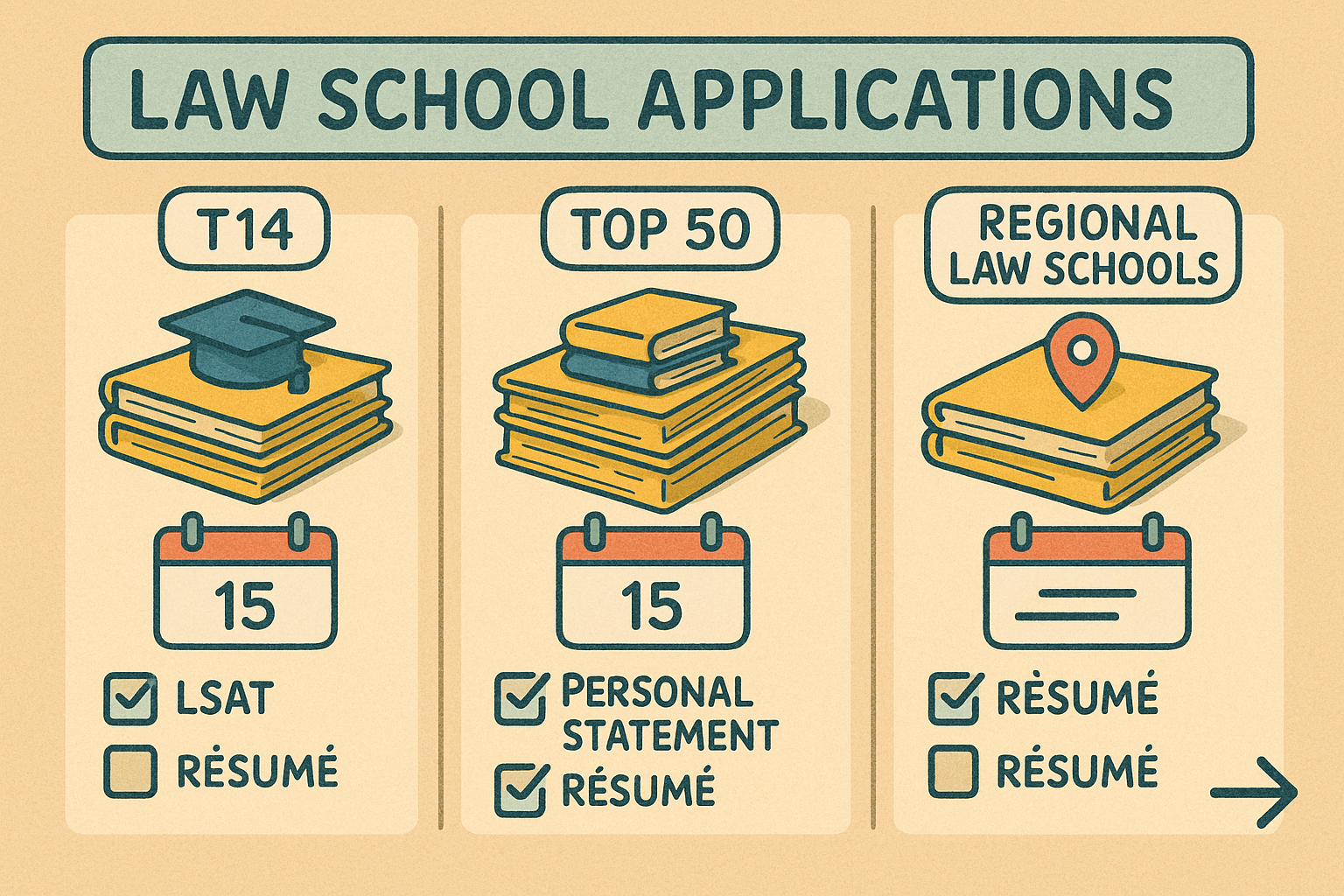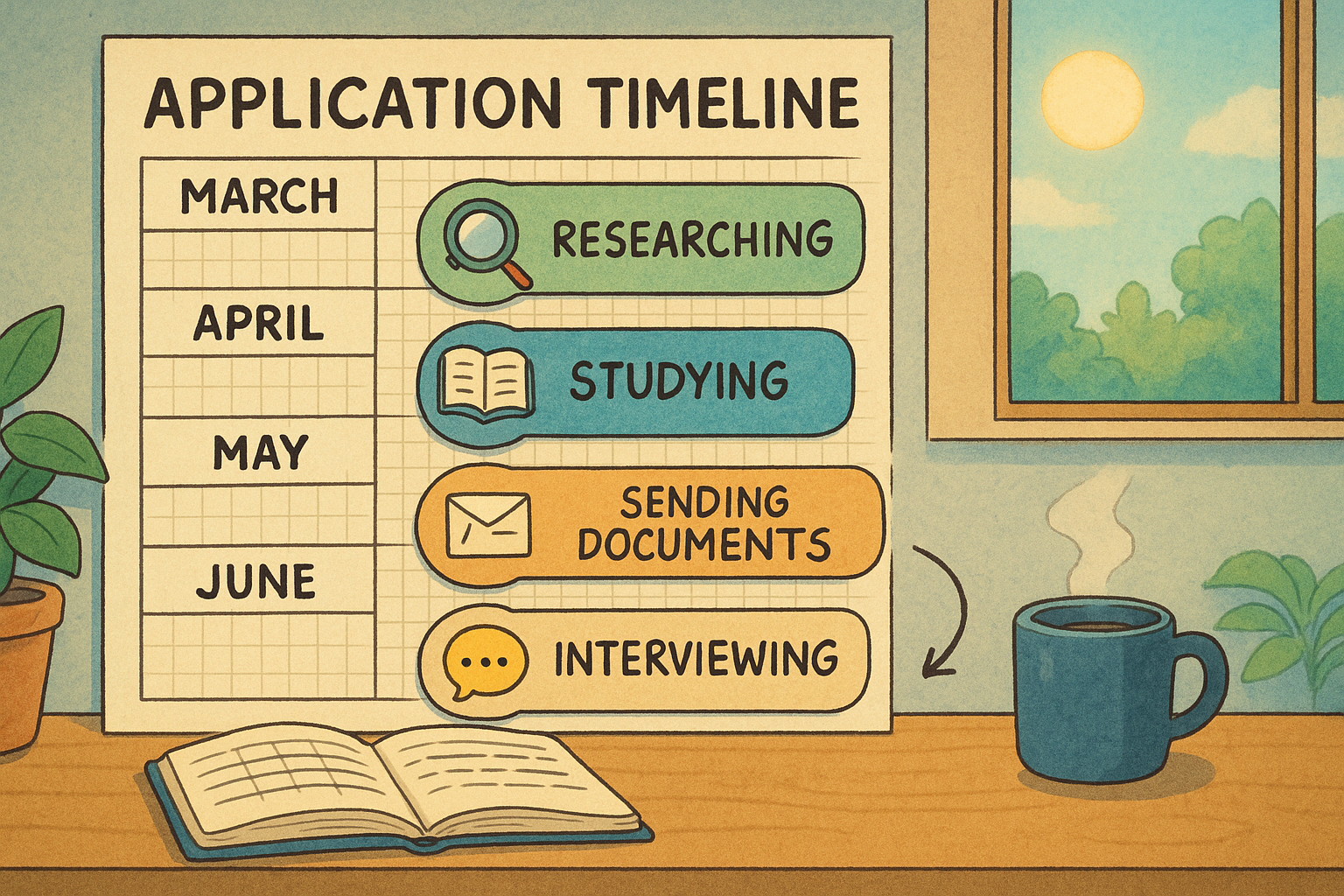Table of Contents
- Understanding the Law School Application Timeline
- Early Preparation 18 to 24 Months Before Enrollment
- LSAT Preparation and Registration 12 to 18 Months Before Enrollment
- Application Components Development 9 to 12 Months Before Enrollment
- Application Submission 6 to 9 Months Before Enrollment
- Post Application Phase 3 to 6 Months Before Enrollment
- Law School Application Requirements by School Type
- Special Considerations for Different Applicant Types
- Creating Your Law School Application Checklist
- Financial Planning for Law School Applications
- Managing Stress During the Application Process
- Common Mistakes to Avoid with Law School Application Deadlines
- How to Recover from Missed Deadlines
- The Advantages of Early Application
Understanding the Law School Application Timeline
The law school application timeline typically spans 18-24 months before your intended enrollment date. This extended period gives you plenty of time to prepare for the LSAT, gather all your documents, and submit polished applications well before crucial deadlines.
Most top law schools use rolling admissions, which means they review applications as they arrive rather than waiting until after the deadline. This makes early submission a smart move, since more seats and scholarship money are available earlier in the cycle.
According to Harvard Law School's admissions office, applications submitted in September and October receive decisions much faster than those submitted closer to deadlines. Their updated timeline for the 2025 application cycle really drives home how important early preparation and submission are.
For a more detailed, step-by-step overview of the latest law school application timeline for 2025 with essential tips for each stage, check out our dedicated guide.
Early Preparation 18 to 24 Months Before Enrollment
The law school application process begins well before you submit any paperwork. This early stage sets the foundation for your success.
During this period, you'll want to do some serious self-reflection about why you want to pursue law and explore potential career paths that interest you. Start researching schools based on location, program strengths, and admission statistics. You should also begin familiarizing yourself with the LSAT format and create a study schedule. Don't forget to start budgeting for application costs, including LSAT fees, CAS registration, and application fees.
Brown University's Pre-Law Advising office suggests using this time to connect with lawyers in fields that interest you. These informational interviews can help confirm your interest in law and provide valuable insights for your personal statement.
If you're just getting started, our step-by-step law school application timeline for 2025 provides actionable advice for every phase, from early research to final submission.
LSAT Preparation and Registration 12 to 18 Months Before Enrollment
The Law School Admission Test (LSAT) is a critical component of your application, and your score significantly impacts your admission chances. This phase of the law school application schedule focuses on mastering this challenging exam.
You'll need to register for the LSAT at least 5-6 weeks before your preferred test date and sign up for the Credential Assembly Service (CAS), which is required by most law schools. Develop a consistent study routine—most successful applicants study 15-20 hours weekly for 3-4 months. Take multiple practice tests under timed conditions and consider LSAT prep courses or tutoring if self-study isn't working for you.
The University of Oregon's Pre-Law Hub recommends taking the LSAT no later than October/November of the year before you plan to enroll. This timing allows you to retake the test if necessary while still meeting application deadlines.
Learn how to optimize your LSAT strategy and meet every milestone with our LSAT preparation and application timeline guide.
Application Components Development 9 to 12 Months Before Enrollment

This phase of the law school application planning process involves developing the various components of your application package. Each element requires careful attention and multiple revisions.
You'll need to craft a compelling personal statement that showcases your writing ability and motivation for pursuing law. Prepare a concise resume highlighting your academic achievements, work experience, and extracurricular activities. Secure strong letters of recommendation from professors or employers who can speak to your abilities. Request official transcripts from all undergraduate and graduate institutions you've attended. Consider whether you need to submit a diversity statement or additional essays that provide context about your background or experiences.
During this period, you should also finalize your list of target schools, considering factors like location, program strengths, admission statistics, and financial considerations.
The University of Chicago Law School suggests beginning your personal statement at least three months before you plan to submit applications, giving yourself plenty of time for feedback and revisions.
Get even more personalized tips on crafting your law school personal statement and gathering strong recommendations in our expert guide on law school application components.
Application Submission 6 to 9 Months Before Enrollment
Understanding law school application dates is critical during this phase. Most law schools begin accepting applications in September for the following fall semester, with deadlines typically falling between February and April.
For Early Decision or Early Action, deadlines usually fall between November 1-15 (binding at some schools). For Regular Decision, the optimal submission time is by Thanksgiving or early December, while standard submission is by mid-January. Final deadlines vary by school, typically between February and April.
Submitting early in the cycle offers several advantages: more seats are available in the incoming class, there are greater scholarship opportunities, you'll likely get faster decisions, and you'll face less competition as many applicants submit closer to deadlines.
U.S. News & World Report's month-by-month guide emphasizes that applications submitted from September through November receive the most favorable consideration due to rolling admissions policies at most law schools.
For law schools with rolling admission policies, see our dedicated guide to rolling admission and application strategies.
Post Application Phase 3 to 6 Months Before Enrollment
After submitting your applications, the law school application process continues with several important steps.
You'll need to regularly check application portals to ensure all materials have been received. Some schools conduct interviews, so be prepared for those. Complete the FAFSA and any school-specific financial aid forms. If you're waitlisted, send letters of continued interest and updates on your achievements. When admission offers come in, carefully evaluate programs, locations, and financial packages. Finally, secure your place in the incoming class by submitting seat deposits, typically due in April.
Harvard Law School notes that decisions for regular decision applicants typically arrive between January and April, with most financial aid packages following shortly after admission offers.
If you want strategic advice on maximizing your chances if you're placed on a waitlist, read our waitlist strategy guide for law and graduate programs.
Law School Application Requirements by School Type

Different types of law schools have varying law school application requirements and competitive timelines. Understanding these differences can help you strategize your applications more effectively.
T14 (Top 14) Law Schools have extremely competitive admissions with earlier unofficial deadlines (optimal submission by November). They typically require higher median LSAT scores and GPAs and have more extensive application requirements, often including optional essays.
Top 50 Law Schools feature very competitive admissions that benefit from early submission (optimal by December). They place strong emphasis on LSAT scores and academic performance and may offer more scholarship opportunities for early applicants.
Regional Law Schools have moderately competitive admissions with more flexible deadlines, though early application is still advantageous. They place greater emphasis on regional ties and commitment to practice locally and may offer specialized programs for local legal markets.
The University of Chicago Law School advises that applicants to top-tier schools should aim to submit applications by Thanksgiving to maximize their chances of admission and scholarship consideration.
For in-depth insights into preparing for Harvard Law School specifically, including requirements and key dates, visit our comprehensive Harvard Law application guide and Harvard Law School deadlines breakdown.
Special Considerations for Different Applicant Types
The law school application timeline may need adjustment based on your personal circumstances. Different applicants should modify their approach accordingly.
Current undergraduates should begin LSAT preparation during junior year and take the LSAT during the summer between junior and senior years. Take advantage of academic resources like pre-law advisors and request recommendation letters before professors forget you.
Working professionals should allow extra time to study for the LSAT while balancing work commitments. Reconnect with former professors well in advance for recommendations, emphasize how your work experience has prepared you for law school, and consider whether to disclose your application to current employers.
Gap year students can use the additional time to gain relevant legal experience and prepare a compelling narrative about how your gap year enhanced your readiness. Stay connected to academic references and consider taking the LSAT during your senior year while still in academic mode.
Brown University's Pre-Law Advising office offers specialized timelines for non-traditional applicants, emphasizing flexibility while maintaining key preparation milestones.
For tailored advice for each applicant profile and what to focus on at every step, see our law school application timeline for 2025.
Creating Your Law School Application Checklist

A comprehensive law school application checklist will help you stay organized throughout this complex process. Here's a master checklist to adapt to your personal timeline:
- 18-24 Months Before Enrollment:
- Research legal careers and speak with practicing attorneys
- Begin researching law schools and admission requirements
- Create LSAT study plan
- Start saving for application expenses
- 12-18 Months Before Enrollment:
- Register for the LSAT and CAS
- Take LSAT prep course or begin self-study
- Identify potential recommenders
- Research financial aid and scholarship opportunities
- 9-12 Months Before Enrollment:
- Take the LSAT (with time for a potential retake)
- Request official transcripts from all institutions
- Formally request letters of recommendation
- Begin drafting personal statement
- Finalize list of target schools
- 6-9 Months Before Enrollment:
- Complete and submit applications
- Submit FAFSA (after October 1)
- Prepare for potential interviews
- Apply for scholarships and grants
- 3-6 Months Before Enrollment:
- Follow up on application status
- Visit schools that have accepted you
- Compare financial aid packages
- Submit seat deposit to your chosen school
- Complete housing arrangements
The University of Oregon's Pre-Law Hub emphasizes the importance of creating a personalized checklist that accounts for your specific circumstances and target schools.
Download our sample law school application checklist and timeline to keep you organized and ahead of deadlines.
Financial Planning for Law School Applications
An often overlooked aspect of the law school application process is financial planning. Application costs can add up quickly:
- Typical Application Expenses:
- LSAT registration: $200+
- LSAT prep materials/courses: $0-$1,500+
- CAS registration: $195
- CAS report fee: $45 per law school
- Application fees: $60-$100 per school
- Travel costs for visits/interviews: Varies widely
To save money, apply for LSAT fee waivers if you're eligible and request application fee waivers. Look for schools that offer application fee waivers for attending virtual information sessions. Be strategic and limit your application list to schools you're genuinely interested in. Take advantage of free LSAT prep resources from libraries and online platforms.
U.S. News & World Report recommends budgeting for these expenses well in advance and seeking fee waivers when possible to make the application process more affordable.
For more advice on affording higher education beyond law school, read our in-depth college financial planning strategies.
Managing Stress During the Application Process
The law school application journey can be emotionally taxing. Incorporating stress management into your law school application planning is essential for maintaining well-being and performing at your best.
Try breaking the application process into manageable weekly tasks and celebrate small victories along the way. Don't neglect physical exercise and healthy sleep habits. Build a support network of friends, family, and fellow applicants. Set realistic expectations about admissions outcomes and remember that many successful lawyers faced rejection from their top-choice schools.
Brown University's Pre-Law Advising emphasizes the importance of self-care during the application process, noting that burnout can negatively impact application quality and LSAT performance.
For strategies tailored to high-stakes admissions, explore our stress management and organization tips within the law school timeline guide.
Common Mistakes to Avoid with Law School Application Deadlines
Even well-prepared applicants can make mistakes that jeopardize their chances. Here are common pitfalls to avoid regarding law school admissions deadlines:
- A major mistake is procrastinating on the LSAT, which limits your retake options.
- Rushing application materials to meet deadlines often results in lower quality submissions.
- Many applicants confuse regular deadlines with earlier scholarship consideration deadlines.
- Not giving recommenders adequate time (at least 4-6 weeks) can lead to rushed or late letters.
- Some applicants ignore school-specific requirements, missing additional essays or unique deadlines.
- Submitting right at the deadline is risky as technical issues could cause you to miss the cutoff.
- Finally, neglecting to follow up to ensure all materials were received properly can leave your application incomplete.
The University of Chicago Law School advises submitting applications at least a week before stated deadlines to avoid technical difficulties and ensure all materials are properly received.
For a breakdown of the most common timeline and submission mistakes, and how to avoid them, check our comprehensive application timeline guide.
How to Recover from Missed Deadlines
If you've missed important law school application dates, all is not lost. Here are recovery strategies:
- If you missed the LSAT registration deadline, register for the next available test date. Use the additional time for more thorough preparation and consider whether this delay affects your overall application timeline.
- If you missed a school's application deadline, contact the admissions office to inquire about flexibility. Ask if they accept late applications on a space-available basis. Consider applying for the following cycle with a stronger application or look into law schools with later deadlines or rolling admissions.
- If you missed the current application cycle entirely, use the gap year productively with a legal internship or relevant work experience. Strengthen your application components and retake the LSAT if your score was below your target schools' medians. Begin the next cycle's process early to avoid similar issues.
Harvard Law School notes that while their official deadline is February 1, applications completed after December may face a longer review process and more competition for limited spots.
Find expert tips for catching up after missed deadlines in our step-by-step law school timeline for 2025.
The Advantages of Early Application
Submitting your applications early in the law school application schedule offers numerous advantages that can significantly impact your admissions outcomes.
When you apply early, more seats are available since schools fill their classes as they go, leaving fewer spots later. Scholarship opportunities are typically better as financial aid budgets may be larger earlier in the cycle. You'll face less competition with fewer applications to compare against yours. Many schools review applications in order of receipt, leading to faster decisions. If waitlisted, you'll have more time for follow-up. Completing applications early eliminates last-minute pressure, and you'll have more time for thorough preparation and review, improving application quality.
According to U.S. News & World Report, applying in September or October can significantly increase your chances at schools with rolling admissions, as they may fill up to 30% of their class from early applicants.
See how timing your submission can boost your odds in our full law school application timeline guide.

